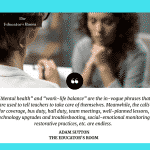Have you signed up for The Educator’s Room Daily Newsletter? Click here and support independent journalism!
I’m sitting down to write this piece on the last official day of my fall break. Tomorrow will be the weekend rush to make sure that the house is ready for my kids and me to return to our regularly scheduled school lives. For the first time ever, I am approaching the end of a two-week fall break right in the middle of my semester.
And I can’t believe I have never experienced this kind of break before.
Oh, I’ve experienced breaks. I’ve been lucky in several years to have a full week for Thanksgiving or two full weeks between the semesters over the Christmas holiday or the traditional full week for spring break.
But two weeks? In the middle of a semester?
Never. After two weeks of time with family and working on my own projects, and not thinking about school more than once or twice, I’ve become more convinced than ever that this is one change regarding education (and our American workaholic culture) that everyone should get on board with.
Teachers and students need breaks
I really shouldn’t have to state the obvious, but humans need breaks. We need breaks from work, and we need breaks from other humans. Studies have shown that taking vacation days lowers stress, increases heart health, and boosts brain power. And this is not just true for adults.
Most educators have experienced those late fall days when students have been doing school with the same people for longer than two months. The stretch before Thanksgiving can be brutal, as can that stretch before spring break when it is more than halfway through the semester. Students struggle to focus as one day drags to the next. Teachers become frustrated with repeated behavior from the same students who just need to take a breath. And students get frustrated with each other, sometimes leading to an increase in fights and visits to guidance counselors.
Our fall break fell right in between quarters. By the time it approached, the daily grind of the semester hadn’t yet pushed me into survival mode. Still, I was eager for a mental and emotional break. In past years of teaching, I’ve gotten maybe two extra days off in October before diving right into standardized testing and the second half of the semester. It’s been exhausting. This time, I’m entering the second half of a semester refreshed, having completed tasks that had been gnawing away at me and eager to get started on new material. It’s the most refreshed I’ve ever felt halfway through the semester. Imagine if this was a standard practice throughout our year and throughout our school system.
Teachers and students need more meaningful breaks, not longer breaks
While American schools have fewer school days per year than the majority of our peer nations, most of our schools still take the bulk of our time off during the summer months. The myth that our summer vacations stem from needs in farming communities continues to make it difficult for school districts to deal with the very real challenges facing changing school calendars, such as budgets, poor school infrastructure, and the realities of our American work culture. While two or more months off in the summer is nice, it also comes with consequences. Summer slide does impact student learning, and while the impact is still up for debate, most teachers can present anecdotal evidence that the first month of school can be spent relearning academic skills and classroom expectations.
I’m not the only teacher who has been frustrated by students taking off in the middle of quarters or semesters, seemingly ignoring pre-scheduled school breaks. However, some parents cannot fit their vacation time into school calendars. Longer breaks would not necessarily get rid of these long absences, but they give families more options that possibly fit family needs. Longer breaks could also mean more meaningful travel and time for recovery on each end of vacation travel, which can potentially benefit school employees, students and their families, and local tourism economies. I had two weeks off, but my two children only had one. If they also had two, we could someday take that fall trip to the Grand Canyon that I dream of taking before they graduate from high school.
We don’t need more days off, but perhaps we need to better distribute the time we take away from learning.
Time off should be part of a bigger movement
Of course, in order for this model to work, we need to give all workers more time off. I fully recognize that my call for more frequent long breaks comes with a significant amount of privilege. I am a teacher, so when my kids are off for these longer breaks, so am I. My husband works from home, and my children are now older and don’t need babysitters.
More school breaks may come easily to our family, but they may be burdensome for others. We must address the toxicity of our current work culture in the United States. U.S. businesses encourage employees to be workaholics. Many employers still do not offer time off for their employees, even when they are sick. If employees are offered time PTO, we praise them for not taking it. I thought that living through a global pandemic would at least cure us of our habit of working while sick, but it doesn’t seem to have cured us even of that workplace issue. We pass this expectation on to our children because we need them to be in school so that we can work. I know that many parents struggled to find affordable childcare for their children before the pandemic, and it has only gotten more difficult in the last three years.
We need to do better, and we have to start somewhere. Maybe that somewhere is in school systems that says rest for teachers and students is important. And then we insist that local employers follow suit.
It sounds idealistic, but change has to start somewhere.
Editor’s Note: If you enjoyed this article, please become a supporter by clicking here.






